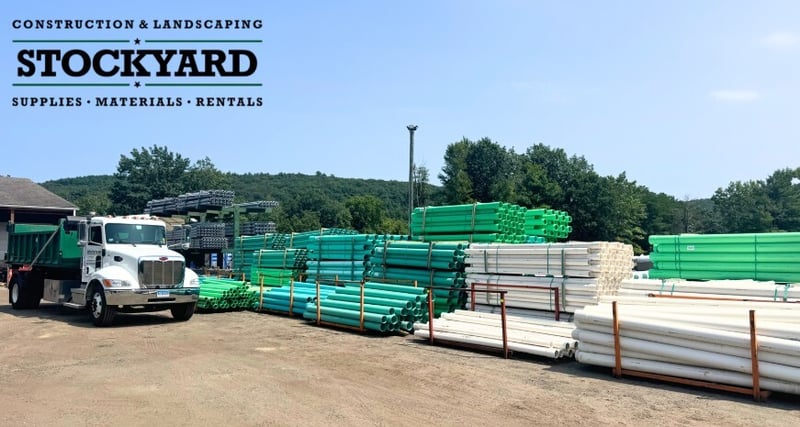Foundation Drainage Pipe: Comparing SDR35, Schedule 40 PVC, and HDPE

Choosing the right foundation drainage pipe is crucial for any construction project. Understanding the differences between SDR35, Schedule 40 PVC, and HDPE can save you time, money, and potential headaches down the road.
Understanding the Basics: What Are SDR35, Schedule 40 PVC, and HDPE Pipes?
When it comes to foundation drainage, selecting the correct type of pipe is essential. SDR35, Schedule 40 PVC, and HDPE pipes all have unique characteristics that make them suitable for various applications. SDR35 is a type of PVC pipe that offers a thinner wall compared to Schedule 40, making it lighter and more flexible. Schedule 40 PVC is known for its thicker walls and higher pressure ratings, providing exceptional strength and durability. HDPE (High-Density Polyethylene) corrugated double wall pipes are known for their flexibility and resilience, especially in challenging soil conditions.
Understanding these basic differences can help contractors make informed decisions on which material to use for specific projects. Each type of pipe can perform well under certain conditions, but knowing the strengths and limitations of each will ensure optimal performance and longevity.
Strength and Durability: Which Pipe Stands the Test of Time?
In terms of strength and durability, Schedule 40 PVC stands out with its thick walls and high-pressure ratings, making it ideal for applications requiring robust performance. It can withstand significant physical stress and is less likely to crack or break under load. SDR35, while still strong, has thinner walls and is more flexible, which can be beneficial in certain scenarios but may not hold up as well under heavy loads.
HDPE pipes offer excellent durability due to their flexibility and resistance to chemical and environmental stressors. They are particularly useful in areas with shifting soils or where chemical resistance is a priority. HDPE pipes can also handle impacts better than rigid PVC, making them a reliable choice for areas prone to ground movement.
Flow Rate and Efficiency: Ensuring Optimal Drainage Performance
Flow rate and efficiency are critical factors in drainage systems. Schedule 40 PVC and SDR35 PVC pipes have smooth interior surfaces that facilitate high flow rates and reduce the potential for clogs. This makes them excellent choices for sewer tie-ins and other applications where consistent flow is essential.
HDPE pipes, with their corrugated exterior and smooth interior, also provide efficient flow rates. The design of HDPE pipes minimizes friction and allows for effective water movement, making them suitable for both large-scale drainage projects and smaller, localized applications.
Installation and Cost: Balancing Budget and Labor
Installation and cost are significant considerations for any construction project. SDR35 is generally more affordable than Schedule 40 PVC due to its thinner walls and lower material costs. It is also easier to handle and install, reducing labor expenses. Schedule 40 PVC, while more expensive, offers superior strength and longevity, which can justify the higher upfront costs in long-term projects.
HDPE pipes are often more expensive than both types of PVC pipes, primarily due to their material properties and manufacturing process. However, their lightweight nature and flexibility can lead to lower installation costs, especially in challenging terrains. The reduced need for fittings and ease of installation can offset the higher material costs over the project's lifespan.
Real-World Applications: Choosing the Right Pipe for Your Project
When it comes to real-world applications, the choice of pipe can significantly impact the project's success. For foundation drainage, HDPE pipes are often preferred due to their flexibility and durability in variable soil conditions. Schedule 40 PVC is suitable for sewer tie-ins and commercial projects where high pressure and durability are required. SDR35 is a cost-effective solution for residential drainage systems where flexibility and ease of installation are critical.
Understanding the specific demands of your project, including soil conditions, load requirements, and budget constraints, will help determine the most suitable pipe. Consulting with suppliers and considering long-term performance and maintenance needs can also guide your decision-making process.
Quick Match Pipe Guide
| Project Type | Recommended Pipe |
|---|---|
| Residential foundation drain | HDPE |
| Sewer line connection | SDR35 or Schedule 40 |
| Commercial/high-load drainage | Schedule 40 or HDPE |
| Sloped or unstable soils | HDPE |
| Budget-conscious residential | SDR35 |
Check Out Our Pipe & Irrigation Page Here

